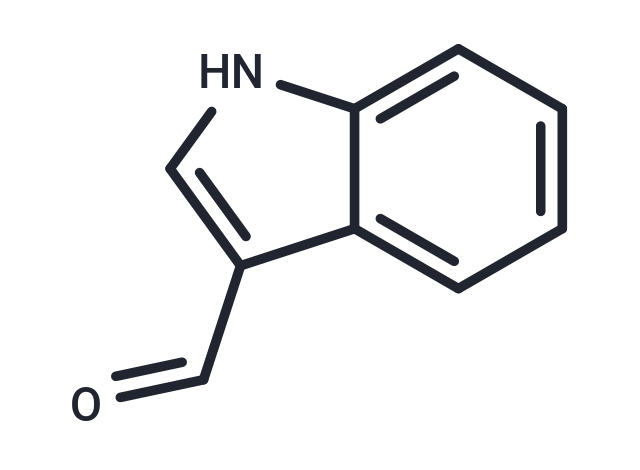- Remove All
 Your shopping cart is currently empty
Your shopping cart is currently empty
Indole-3-carboxaldehyde
1H-Indole-3-carboxaldehyde (3-Formylindole), also known as 3-formylindole or 3-indolealdehyde, belongs to the class of organic compounds known as indoles. Indoles are compounds containing an indole moiety, which consists of pyrrole ring fused to benzene to form 2,3-benzopyrrole. 1H-Indole-3-carboxaldehyde is an extremely weak basic (essentially neutral) compound (based on its pKa). Outside of the human body, 1H-Indole-3-carboxaldehyde has been detected, but not quantified in, several different foods, such as gram beans, brussel sprouts, cucumbers, cereals and cereal products, and white cabbages. This could make 1H-indole-3-carboxaldehyde a potential biomarker for the consumption of these foods. A heteroarenecarbaldehyde that is indole in which the hydrogen at position 3 has been replaced by a formyl group.

Indole-3-carboxaldehyde
| Pack Size | Price | Availability | Quantity |
|---|---|---|---|
| 100 mg | $42 | In Stock | |
| 1 mL x 10 mM (in DMSO) | $46 | In Stock |
Product Introduction
| Description | 1H-Indole-3-carboxaldehyde (3-Formylindole), also known as 3-formylindole or 3-indolealdehyde, belongs to the class of organic compounds known as indoles. Indoles are compounds containing an indole moiety, which consists of pyrrole ring fused to benzene to form 2,3-benzopyrrole. 1H-Indole-3-carboxaldehyde is an extremely weak basic (essentially neutral) compound (based on its pKa). Outside of the human body, 1H-Indole-3-carboxaldehyde has been detected, but not quantified in, several different foods, such as gram beans, brussel sprouts, cucumbers, cereals and cereal products, and white cabbages. This could make 1H-indole-3-carboxaldehyde a potential biomarker for the consumption of these foods. A heteroarenecarbaldehyde that is indole in which the hydrogen at position 3 has been replaced by a formyl group. |
| Alias | 3-Formylindole |
| Molecular Weight | 145.16 |
| Formula | C9H7NO |
| Cas No. | 487-89-8 |
| Smiles | O=CC1=CNC2=CC=CC=C12 |
| Relative Density. | 1.278 g/cm3 |
| Storage | Powder: -20°C for 3 years | In solvent: -80°C for 1 year | Shipping with blue ice. | |||||||||||||||||||||||||||||||||||
| Solubility Information | DMSO: 55 mg/mL (378.89 mM), Sonication is recommended. | |||||||||||||||||||||||||||||||||||
Solution Preparation Table | ||||||||||||||||||||||||||||||||||||
DMSO
| ||||||||||||||||||||||||||||||||||||
Calculator
In Vivo Formulation Calculator (Clear solution)
Dose Conversion
Tech Support
Keywords

Copyright © 2015-2025 TargetMol Chemicals Inc. All Rights Reserved.



